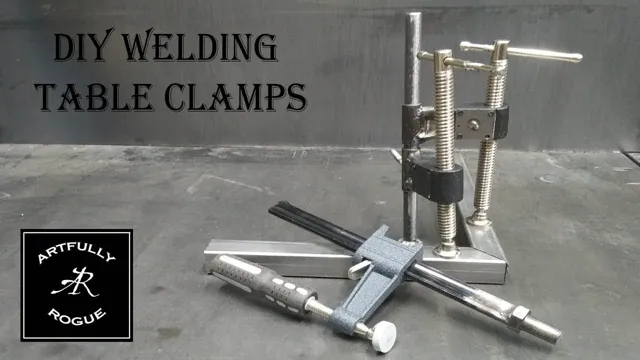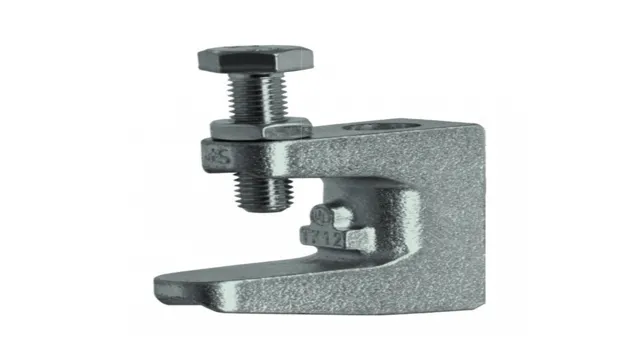How Do Welding Table Clamps Work to Secure Metal Joints?

Have you ever found yourself struggling to keep your workpiece in place while welding? Whether you’re a hobbyist or a professional, welding table clamps can be a game-changer when it comes to securing your work and achieving precise results. But with so many different types of clamps available, it can be overwhelming to choose the right ones for your needs. In this blog post, we’ll explore the ins and outs of welding table clamps, including their different types, sizes, and uses.
By the end of this article, you’ll have a better understanding of how to use welding table clamps to make your welding projects a success.
Introduction
Welding table clamps are essential tools for any welding job. These clamps serve as a solution to hold down the metal being worked on in the right position, ensuring that the welding work is done accurately and precisely. Welding table clamps work by clamping down on the sides of the metal piece, providing a stable point for welding.
The clamps exert pressure on the metal, holding it in place even when being welded. Additionally, welding table clamps come in various types, including C-clamps, crossbars, and hand screw clamps. Each of these clamps works uniquely and serves different purposes in welding.
Whether you are working on a small or large welding project, using welding table clamps guarantees stability and accuracy in your welding work.
What are welding table clamps?
Welding table clamps are an essential tool for any welding project, as they serve the important function of holding the workpiece securely in place during the welding process. They come in various shapes, sizes, and types, and are designed to provide a strong grip on the workpiece, ensuring that it stays firmly in place while the welder works on it. Clamps are commonly used in welding to hold two pieces of metal together, align components for welding, and hold a piece of material in place while it is being welded.
They make welding easier and more efficient by providing a secure hold on the workpiece, which allows for greater accuracy and precision in welding. A well-designed welding clamp can greatly improve the quality of the finished product, making it an essential tool for any welding professional or enthusiast.

Why are welding table clamps important?
Welding table clamps are essential tools that every welder must have for their workshop. These clamps are used to hold the workpiece securely in place while welding. Welding can be a tricky business, and without the right equipment, it can be difficult to get the job done properly.
That’s where welding table clamps come in; they provide a stable base for the workpiece and ensure that it stays in place during the welding process. The clamps come in different shapes and sizes, and they are designed to fit different types of workpieces. In this blog post, we’ll take a closer look at why welding table clamps are so important and why every welder should have them in their arsenal of tools.
Types of Welding Table Clamps
Welding table clamps are an essential tool for all welders, especially for those working with intricate projects that require a high level of precision and accuracy. These clamps come in different shapes and sizes, each designed to fulfill a specific purpose. One type of clamp is the C-clamp, which has a C-shaped frame and is ideal for holding different materials together.
Another type is the locking pliers, which are versatile and can be used for holding, tightening, and adjusting workpieces. The third type is the magnetic clamp, which uses magnets to hold the workpiece in place, making it ideal for use on metal surfaces. Regardless of the type, all welding table clamps work by securely holding the pieces in place to prevent any movement during the welding process.
This allows the welder to work with precision and accuracy, resulting in a high-quality finished product.
C-Clamps
C-Clamps When it comes to welding, having the proper clamps can make a world of difference in the quality and efficiency of your work. One popular type of clamp is the C-clamp, also known as a G-clamp, due to its resemblance to the letter “C” or “G” when in use. This versatile clamp can be used on a variety of welding tables, and comes in different sizes and styles to suit your needs.
For example, a deep throat C-clamp is great for clamping onto thicker materials, while a regular C-clamp is perfect for lighter duty work. Additionally, locking C-clamps have a locking mechanism to ensure a more secure hold on your workpiece. Whatever your needs may be, investing in a high-quality set of C-clamps is a smart move for any welder.
Locking Pliers
Locking pliers are an essential tool in welding that provide a strong grip and hold on various materials. There are many types of welding table clamps, and locking pliers are a popular choice for their versatility. One type is the standard locking pliers, also known as vise-grips, which have a long, curved jaw that locks into place, allowing for a secure grip on a variety of shapes and sizes.
Another type is the sheet metal locking pliers, which have a flat jaw that is ideal for gripping thinner materials like sheet metal. These pliers are useful for clamping workpieces together during welding and can also be used for other tasks like bending and shaping metal. Overall, locking pliers are a multipurpose tool that is a valuable addition to any welder’s toolkit.
Magnetic Clamps
Magnetic Clamps, Welding Table Clamps If you’re a welder, you know the importance of having the right tools for the job. One of the most essential tools in your kit are clamps, which hold your workpiece securely in place while you work. Magnetic clamps are a popular option among welders due to their ease of use and versatility.
There are a few different types of welding table clamps, including magnetic ground clamps, magnetic v-blocks, and magnetic base clamps. Magnetic ground clamps are used to create a grounding point for your welder, while magnetic v-blocks are designed to hold round or irregularly-shaped objects in place. Magnetic base clamps are ideal for holding flat objects, and can often be adjusted to different positions and angles.
Whatever your needs, magnetic clamps can make your welding work smoother and more efficient. So why not add a few to your kit today?
Spring Clamps
If you’re a welder, you know that the right clamps can make all the difference in your work. One type of clamp that’s essential to have in your toolbox is the spring clamp. Spring clamps are perfect for holding small pieces of metal in place during welding and can accommodate various thicknesses.
These clamps work by using a spring mechanism to apply pressure to the material, ensuring that it stays in place and that you can work efficiently. But, spring clamps aren’t the only welding table clamps to consider. Welding pliers, C-clamps, and locking clamps are all useful in different ways, depending on the type of project you are working on.
Pliers, for example, can be used to hold welding wire, while C-clamps are ideal for holding larger pieces of metal in place. Locking clamps, on the other hand, are perfect for when you need to hold something in that position for a more extended period. So, it’s essential to have a variety of clamps on hand to ensure that you can tackle any welding project that comes your way.
How Do Welding Table Clamps Work?
Welding table clamps are an essential tool to hold materials in place during welding. They come in different types, shapes, and sizes but all work the same way. The clamps are designed to hold the material firmly and securely in place, while allowing the welder to work around it with ease.
Some have a locking mechanism that keeps the clamp in place while others have a screw-like mechanism that allows for adjustments to be made to the clamp. It is important to choose the right type of clamp for the job as they can hold different types of materials. Clamps are commonly made of steel or other metals that are sturdy and durable.
The use of clamps ensures precise welding and prevents the material from moving during the welding process, which can cause defects in the final product. Overall, welding table clamps are a must-have for any type of welding project, providing a stable and secure work surface for a successful weld.
Step-by-Step Guide
Welding table clamps are essential tools for any welding project. These clamps work by providing a secure hold on the metal pieces being welded together, ensuring that they stay in place throughout the welding process. Most welding table clamps feature a strong, sturdy body with a clamping mechanism that can be tightened down to grip the metal piece tightly.
This helps to prevent the metal from shifting or moving during welding, which could compromise the quality of the weld. Some welding table clamps are designed to be adjustable, allowing the user to position them in a variety of different ways to suit the needs of their specific welding project. Overall, welding table clamps are simple but highly effective tools that can make a big difference when it comes to achieving high-quality welds.
So, whether you’re working on a small DIY project at home or a larger commercial welding job, be sure to invest in a good set of welding table clamps to make your work easier and more efficient.
Tips for Using Welding Table Clamps
Welding table clamps are an essential tool for welding projects of any size. These clamps work by securely holding materials in place on a welding table to prevent any movement during the welding process. The clamps use a combination of a screw and a lever mechanism to grip the material tightly, ensuring precise and accurate welding.
It is important to choose the right type of clamp for the job, as there are various sizes and shapes available for different materials. Welding table clamps are especially useful for holding irregular-shaped pieces or materials with odd angles in place, allowing for easier and more precise welding. Using welding table clamps can save you time and improve the accuracy of your welding work, so be sure to pick up a few for your toolkit.
Conclusion
To put it simply, welding table clamps are the glue that holds your workpiece in place while you get all hot and steamy with your welding torch. They ensure a stable and secure grip so you can focus on creating a masterpiece (or at least a solid joint). It’s like having a third and very helpful hand that never complains or asks for a break.
In short, welding table clamps are the unsung heroes of the welding world – keeping our workpieces steady and our sanity intact.”
FAQs
What are welding table clamps used for?
Welding table clamps are used to secure metal pieces in place during the welding process.
How do welding table clamps work?
Welding table clamps work by applying pressure to hold the metal piece in place while it is being welded.
Can welding clamps be used on any type of metal?
Yes, welding clamps can be used on most types of metal, including steel, aluminum, copper, and brass.
Are welding table clamps necessary for welding?
Welding table clamps are not always necessary, but they can make the welding process easier and more efficient by holding pieces in place securely.
What are the different types of welding table clamps?
The different types of welding table clamps include C-clamps, locking pliers, and magnetic clamps.
How do you choose the right welding table clamp?
The right welding table clamp for your project will depend on the size and shape of your metal pieces. Consider the material, thickness, and shape of your pieces when choosing a clamp.
Can welding table clamps damage the metal being welded?
Welding table clamps can cause some minor indentation or marking on the metal surface, but this is generally not a problem as these marks can be removed with a grinder or sander.



